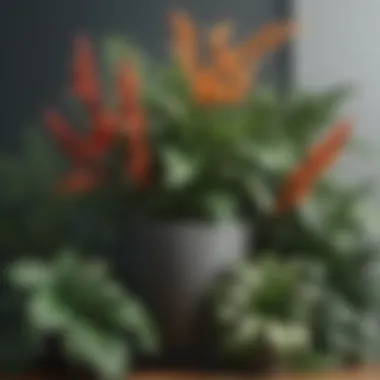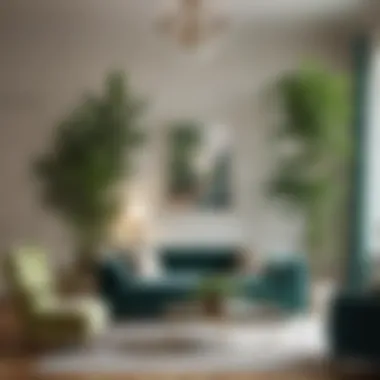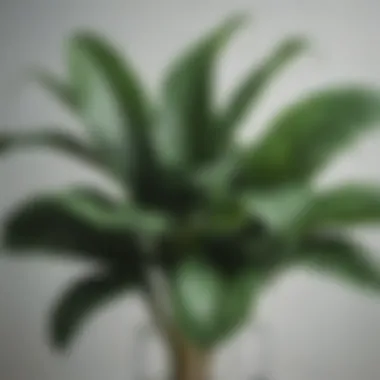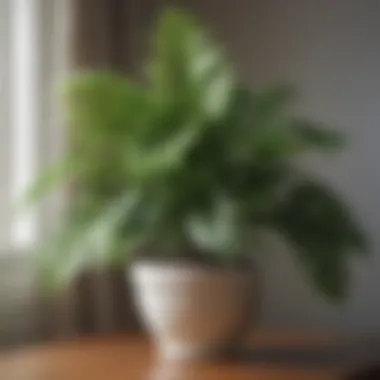Silk Plants Direct: Your Guide to Artificial Greenery


Intro
In our quest for creating inviting and vibrant living spaces, the role of greenery cannot be understated. While fresh plants bring life, silk plants offer an attractive alternative that provides beauty without the fuss of maintenance. With silk plants direct, homeowners, interior designers, and decor enthusiasts can elevate their interiors without the worry of sunlight, watering, or pests.
This guide delves deep into the world of silk plants, exploring their varieties, advantages, and styling techniques. Whether you’re sprucing up a cozy nook, staging a home for sale, or designing a chic commercial space, understanding how to effectively incorporate artificial greenery is key to achieving a luscious look with minimal effort.
Choosing the right silk plants is only part of the story. It’s also essential to consider how furniture styles and overall design trends influence the way these plants can be showcased. Let's look at how to blend silk plants seamlessly into your existing decor.
Understanding Silk Plants
Silk plants have become a staple in modern decor, providing a breath of freshness without the responsibilities that come with live greenery. Understanding silk plants is essential for anyone looking to enhance their spaces with greenery that does not demand the same care as traditional plants. They are beautifully crafted, often indistinguishable from the real deal, and offer a versatile solution for various interior design needs.
Definition and Overview
Silk plants, despite their name, can be made from various materials such as polyester, plastic, and sometimes silk. They are designed to mimic the appearance of natural plants and flowers closely. This blend of artistry and technology allows silk plants to retain their beauty over time, often requiring nothing more than a light dusting to maintain their allure. These artificial options are particularly valuable in homes or offices where real plants struggle to thrive due to inadequate light or humidity levels.
Silk plants come in numerous varieties, from towering trees like ficus and palms to delicate flowering plants that can brighten any room. Some folks prefer the over-the-top floral arrangements that can lift a dull corner into something vibrant without breaking a sweat. Others find the more understated options appealing, offering just enough greenery to make a space feel alive without overwhelming it.
History of Artificial Plants
The origins of artificial plants date back centuries, but they gained immense popularity during the 20th century. Initially made from silk and featuring painstaking craftsmanship, these plants were luxurious decor items, only available to an elite crowd. As mass production techniques evolved post-World War II, the accessibility and affordability of artificial plants increased. Offering a carefully curated facade of nature without the hassle, it wasn’t long before they infiltrated homes everywhere, maintaining relevance in today’s fast-paced world.
Historically, silk plants were somewhat frowned upon; they were often viewed as a poor substitute for the real thing. However, advancements in manufacturing processes have transformed the market substantially. Today’s options boast meticulous detail, with realistic textures and colors that can fool even the keenest eyes under the right lighting. The shift in perception speaks to broader trends in home decor; people increasingly appreciate the pragmatic benefits of silk plants while also celebrating their aesthetic contributions to both residential and commercial spaces.
"A wise gardener once said, 'Artificial plants don’t wilt nor do they ask for sunlight.'"
For many, integrating silk plants into their decor is synonymous with embracing a life that recognizes the beauty of nature while balancing the demands of modernity. They allow individuals to express their style without the seasonal pressures that real plants tend to bring.
Benefits of Silk Plants
Silk plants have jumped into the spotlight, and their allure can’t be overlooked. As a man-made alternative to live greenery, they carry a variety of advantages that might make them the ideal choice for modern homes and commercial spaces alike. This section will delve into the reasons why silk plants are more than just pretty decorations; they offer practical benefits that resonate with both homeowners and designers.
Maintenance-Free Appeal
One of the most soothing aspects of silk plants is their maintenance-free quality. Unlike real plants, which demand regular watering, pruning, and frequent attention, silk plants let your worries drift away. That means you can fill your home with greenery without the need for daily care. Imagine having a lush, vibrant jungle in your living room without ever having to lift a watering can or worry about them wilting unexpectedly.
"Silk plants look fabulous and stay fabulous!"
Moreover, there are no pests to battle with, unlike their live counterparts, which often invite unwelcome guests like aphids and spider mites. You can enjoy the benefits of nature without having to invest hours in upkeep. If you’re someone that has a tight schedule or simply prefers low-maintenance home decor, silk plants are the way to go.
Seasonal Flexibility
Seasonal changes can bring joy but also hassle, especially when it comes to decorating. Real plants often require careful planning for each season. On the other hand, silk plants stand tall through rain or shine, making them a flexible choice for any time of the year.
Whether you want to mimic the vibrant colors of spring or set a cozy vibe in winter, silk plants allow you to easily switch out arrangements without the need to change your whole decor. Spring flowers give way to rich autumnal tones with minimal effort. They provide a consistent look and feel, so you can focus on creating moods rather than worrying about plant care.
- Spring Blooms: Bright and cheerful, perfect for revitalizing a space.
- Summer Greens: Lively and fresh, ideal for a breezy ambiance.
- Autumn Hues: Earthy tones can create warmth and coziness.
- Winter Whites: Crisp designs fit right in for a chic, modern look.
This inherent adaptability can save time and effort, allowing homeowners to express themselves freely throughout the year.
Allergy-Friendly Option
Another aspect worth featuring is the allergy-friendly nature of silk plants. For those who suffer from pollen allergies or sensitivities, real plants can often worsen symptoms. On the flip side, silk plants provide a beautiful, vibrant alternative that won’t provoke reactions. You can grace your home with natural beauty without risking a sneeze or itchy eyes.
Silk plants also come with the bonus of being quite realistic in appearance. Modern manufacturing methods allow for remarkably lifelike designs. This means you can surround yourself with lushness without sacrificing comfort or health. They are indeed a smart choice for creating an inviting atmosphere without the nuisance of allergens.
Types of Silk Plants Available
When it comes to discussing silk plants, understanding the various types available is essential. Silk plants aren't a one-size-fits-all; they offer a plethora of options that cater to diverse aesthetic preferences and practical requirements. Each type serves different purposes in home decor and landscaping, allowing homeowners and designers to tap into their full potential. With the right information at your fingertips, choosing the ideal silk plant becomes a straightforward affair that can fulfill your decorative dreams without the hassle of traditional plant care.
Indoor Silk Plants
Indoor silk plants are the unsung heroes of home decor, often elevating the atmosphere of a room without demanding the constant attention that real plants do. They come in various shapes and sizes, from towering fiddle leaf figs to delicate peace lilies. One significant advantage of indoor silk plants is their adaptability. Whether it’s a narrow hallway or a cozy nook, there's generally a silk plant suited for the space. Here are a few notable types:
- Fiddle Leaf Fig: This tall, sculptural plant is a favorite in modern decor, providing a dramatic effect without the stress of wilting leaves.
- Snake Plant: Known for its hardy nature, the snake plant adds an architectural element, perfect for neglect-prone indoor settings.
- Peace Lily: Offering elegant white flowers and lush green foliage, it not only adds beauty but also can improve indoor air quality.
Outdoor Silk Plants
Outdoor silk plants are a game changer for those who want a splash of greenery without the environmental challenges real plants often face. They can endure elements like rain, sunlight, and wind without fading or losing their form. A wise choice for porches, balconies, and gardens, outdoor silk plants boast a wide range. Consider these options:
- Silk Bougainvillea: This vibrant, colorful imitation can give your outdoor space a tropical feel regardless of climate conditions.
- Artificial Palm Trees: Providing a resort-like ambiance, they've become favorites for patios and decks.
- Silk Ivy: Climbing or trailing varieties can embellish fences or outdoor furniture, giving the illusion of a lush, vibrant space.
Silk Flowers vs. Greenery
Choosing between silk flowers and greenery can feel like walking a tightrope for some. They serve distinct purposes. Silk flowers can bring a pop of color and offer seasonal charm, making them perfect for unparalleled vibrancy and decoration in a room. They can create themes for events or even day-to-day settings with ease. On the other hand, greenery provides a grounding effect, restoring balance to your decor through lushness and texture.
Here's how they stack up:
- Silk Flowers: Ideal for seasonal displays, they can incorporate colors and varieties that might not be available naturally all year round. They can be showcased in vases or even incorporated into arrangements that make a statement.
- Silk Greenery: Generally more versatile and useful in creating a cohesive, calming environment. Think of using it in large planters, hanging baskets, or even draped over shelves.
Each type of silk plant comes with benefits and specific uses, tailoring to different styles and preferences. This knowledge equips homeowners and designers with the tools to curate spaces that resonate with life, allowing them to be creative without veering into maintenance hell.
"Silk plants give you the looks without the labor, allowing you to keep your focus on creating rather than caring."
By clearly grasping the variety of silk plants available, you're positioned to make thoughtful decisions that will elevate both aesthetic value and functional use in your interior or outdoor designs.
Factors to Consider When Choosing Silk Plants
When it comes to selecting silk plants, homeowners and interior designers need to consider a few crucial factors that can ensure they make the right choice. While the charm of artificial greenery can be enticing, not all silk plants are created equal. Delving into these elements can help you find options that not only beautify your space but also provide a good return on investment.
Quality Indicators
A major factor to examine is the quality of the silk plants. The materials used can make a significant difference in how realistic and durable the plants appear and feel. Higher-quality silk plants employ materials designed to mimic the light and texture of real foliage. This often means the leaves have a subtle sheen, and the colors are varied and rich, capturing the essence of natural plants. When evaluating quality, here are some questions to ponder:
- Is the material soft to the touch?
- Do the leaves have realistic veins and textures?
- How well do the plants hold their shape under slight pressure?


One should aim for plants that exhibit a level of craftsmanship. Look for plants with wires in their stems and branches; this allows for adjusting the foliage to your liking. In the end, choosing higher-quality silk plants translates into a sophisticated look that artificial greenery should provide.
Size and Scale
Size matters when choosing silk plants. The scale of these artificial plants should be proportional to the space where they will be placed. A giant potted ficus could enhance an empty corner of a spacious living room, while something petite—like a mini succulent—might suit a kitchen counter better. Consider the following recommendations:
- Measure your space: Before purchasing, take measurements of where you intend to place the silk plant. Having a blueprint can guide your selection.
- Think vertically: Tall plants can create visual interest and draw the eye upward, making them ideal for low-ceilinged spaces.
- Group plants for effect: Using multiple smaller plants together in various heights can create depth and engagement in your decor.
Color Realism
Realism in color is fundamental to silk plants’ appeal. An overly vibrant or unnatural hue can easily reveal an artificial plant's true nature. Look for colors that resonate with the plants found in nature. Keep an eye out for the following:
- Subtle variations: Just like real plants, silk variations can benefit from gradients or a mix of shades within their foliage.
- Seasonal colors: For example, autumn hues can be warmer and richer, while spring selections should embody fresh and bright tones.
- Atmosphere fitting: Ensure your silk plants fit cohesively within the existing color palette of your home decor.
"Choosing the right silk plants is not just about picking something pretty. It’s about selecting pieces that will complement your space and stay true to their intended design essence."
In summary, consider quality, size, and color realism when selecting silk plants. These facets help you curate an arrangement that enhances your decor and proves to be a satisfying addition to your environment.
Caring for Silk Plants
When it comes to integrating silk plants into your living space, there’s more to it than simply plopping them on the shelf and calling it a day. The reality is, caring for silk plants is essential to ensure they not only look good but last longer. While they don’t require the same level of attention as their live counterparts, a little maintenance goes a long way in keeping them vibrant and appealing.
Dusting and Cleaning
Regular dusting is one of the most straightforward yet effective ways to maintain your silk plants. These items can accumulate dust faster than you might think, making them look dull and lifeless over time. A simple feather duster can do wonders for a quick refresh.
However, for a deeper clean, gently wipe down the leaves with a damp cloth. Just avoid soaking them, as excess water can cause the materials to deteriorate. For those stubborn spots, a soft bristle brush can help dislodge dirt without risking damage. In a pinch, it's okay to use a mild soap mixed with water but be cautious and rinse the leaves thoroughly afterward.
Why is this important? Because a clean plant catches the eye, drawing attention to it in the best possible way. Consider mixing up silk plants of varying textures. The contrast will pop even more against a clean backdrop.
Avoiding Sunlight Damage
Even though silk plants are crafted to mimic the look of real foliage, they’re not entirely impervious to environmental factors, particularly sunlight. Prolonged exposure to direct sunlight can fade the colors and affect the texture. This can make your investments look cheap or, worse, like they’re from the clearance section of the local home goods store.
To safeguard your silk greenery, consider the positioning carefully. Avoid placing them near windows where sunlight beams directly at them all day. Instead, opt for locations where they can still add vibrancy without the risk of UV damage. If you really want that sunlit aesthetic, you could explore UV-protective sprays designed specifically for synthetic materials.
Maintaining silk plants isn’t just about keeping them clean; it’s a matter of positioning and protection as well. A little foresight in care can ensure they remain a centerpiece of beauty in your decor.
By implementing these straightforward tips, you can extend the lifespan of your silk plants significantly. The investment in time and care is minimal compared to the prolonged enjoyment and aesthetic enhancement they offer.
In summary, dusting and avoiding direct sunlight are critical aspects of caring for silk plants. With thoughtful maintenance, these artificial treasures can thrive beautifully within your curated interior spaces.
Styling Silk Plants in Home Decor
Incorporating silk plants into home decor is not just about adding a splash of green; it's about creating a harmonious atmosphere that reflects personal style. The beauty of silk plants lies in their versatility and the myriad ways they can enhance your living space. As artificial greenery gains traction among homeowners and designers alike, understanding how to style these elements effectively becomes crucial.
Benefits of Silk Plant Styling
Utilizing silk plants can offer the visual appeal and vitality of nature without the commitment of live plants. They can liven up dreary corners, create focal points, and even play a role in defining a room's aesthetic. A well-placed silk plant can be a conversation starter or simply provide a serene backdrop to your busy life.
Creating Visual Impact
Silk plants can serve as striking decor pieces when strategically positioned. Think about scale and proportion; a large floor plant in a cozy corner can act as an anchor, while smaller varieties can accentuate shelves or tables. Using varying heights can create depth and draw the eye.
- Focal Points: Placing a tall artificial palm in a brightly lit corner not only draws attention but also provides balance to the room.
- Layering: Combine different sizes and shapes to create a dynamic arrangement that feels more alive.
Mixing with Natural Elements
A common misconception is that silk plants can't coexist with live plants. On the contrary, the two can complement each other beautifully. When paired with real greenery, silk plants can enhance the overall appearance without the need for constant upkeep.
- Textural Contrast: By mixing materials like wood, ceramic, or metal with silk plants, you can create a richer visual narrative. For instance, placing a silk fern next to a rustic wooden bowl can add warmth and contrast.
- Natural Lighting: Position silk plants near windows with live plants to capitalize on the natural light effect, making the space feel lively and inviting.
Utilizing Space Efficiently
In tighter spaces, silk plants can be a smart way to bring life without consuming your square footage. Using vertical space is key here.
- Wall-mounted Planters: These can hold silk arrangements, providing a green touch without taking up floor space.
- Corner Shelves: A small arrangement of silk succulents can turn an empty shelf into a vibrant display.
With all these options, the goal is to mix creativity and function. By thoughtfully arranging silk plants in your home, you're not just decorating; you're crafting an environment that promotes peace, elegance, and an effortless beauty that resonates with your personal aesthetic.
Common Misconceptions about Silk Plants
When discussing silk plants, many people harbor preconceived notions that can cloud their judgment about these elegant additions to home decor. It's important to debunk these misconceptions as they can greatly influence purchasing decisions and the overall perception of the quality and utility of silk plants. By examining these misunderstandings, we can uncover the truths that make silk plants a worthy inclusion in any setting.
Cost vs. Quality
One common misconception about silk plants is the belief that a lower price directly equates to inferior quality. While it’s easy to assume that the high cost of some silk plants indicates superior craftsmanship, this isn't always the case. The truth is that silk plants vary widely in price, but that variation is often linked more to branding than to intrinsic quality.
When shopping for silk plants, it’s wise to consider the materials and construction techniques used. Cheaper versions may use lower-quality polyester that looks artificial, while premium options might feature richer fabrics and more intricate designs that mimic real foliage. For example, brands like Nearly Natural or Afloral often maintain a higher standard in terms of craftsmanship and design integrity, leading to a more lifelike appearance and durability.
The old adage "you get what you pay for" does hold some weight in the realm of silk foliage, but it’s essential to do your homework. Read reviews and customer feedback to get a sense of what others think about the plants you're considering. Doing so ensures that you’re making informed choices that balance cost against quality without falling victim to marketing gimmicks.
Perceived Lack of Realism
Another significant misconception is the idea that silk plants lack realism. Many people associate artificial plants with the low-quality versions they may have encountered in the past—those brittle leaves and bright, unnatural colors that shout "fake" from across the room. However, the landscape of artificial greenery has transformed dramatically over the years.
Advancements in materials and manufacturing processes have allowed for silk plants that closely mirror the textures and colors of live plants. Some high-end varieties are so true-to-life that they can only be identified as artificial upon close inspection. For instance, the delicate leaves of an artificial monstera can look remarkably similar to their real counterparts, flaunting unique variegation and lifelike striations.
"Today's silk plants are designed to replicate nature so accurately that sometimes it's hard to tell them apart from the real thing."
To enhance realism even further, combining silk plants with natural elements can amplify their aesthetic appeal. Designers often place silk ferns beside real stones or wood textures to ground the display, tricking the eye into interpreting the scene as more authentic. So, when evaluating silk plants, it’s vital to go beyond surface judgments and consider how they can truly add value to your decor.
By addressing these common misconceptions, homeowners and decorators can make better-informed choices that enhance the beauty of their spaces without falling prey to outdated ideas about artificial greenery.
Comparing Silk Plants to Live Plants
When one plunges into the realm of home decor, the debate between silk plants and live counterparts often resurfaces. Although both have their merits, it's crucial to examine what truly sets these artificial green beauties apart from the living guys.


Silk plants often shine when durability and long-term investment are on the table. After all, they don’t demand sunlight or frequent watering to thrive. This practicality can make them especially appealing for individuals with hectic lifestyles or those who may not possess a green thumb.
Longevity and Sustainability
Often, longevity is the crown jewel in the silk plant category. Unlike live plants, which can wither over time, silk plants can last for many years with proper care. Here are some key points to consider:
- Timeless Style: Silk plants retain their appearance, making them suitable for various themes and developments over time.
- Resource Efficiency: With silk plants, there's no need to repeatedly purchase new greenery as they fade or perish. This not only saves money but contributes to less waste.
- Zero Seasonal Constraints: They’ll remain fresh-looking regardless of seasonal changes, unlike live plants which may droop or require different care in winter.
The sustainability aspect often ties closely with longevity. A silk plant doesn’t necessitate the resources needed for live plants over their lifetime. Fewer products are consumed for maintenance, less water is utilized, and those beautifully curated arrangements can hold their ground against time.
Aesthetic Versatility
Silk plants can easily adapt to various decorative themes—think of them as the chameleons of decor. This versatility can be a major selling point. Here’s why:
- Diverse Shapes and Sizes: Whether someone desires a towering floor plant or delicate table centerpieces, options abound. Such variety means they can seamlessly fit into any space.
- Color Options: They are available in a rainbow of hues, which can add pops of color without the demands of live plants that may be limited to natural variations. This characteristic can be harnessed for themed events or seasonal celebrations.
- Create Layers: When it comes to arrangements, layering various heights and textures can evoke a more dynamic visual appeal, a trick not easily executed with live plants that need specific environmental conditions to thrive.
As you consider bringing greenery into your home or office, it becomes apparent that while live plants offer their own charm, silk plants present a compelling argument for longevity and aesthetic adaptability. With the ability to remain vibrant through years, and the versatility to enhance a multitude of design schemes, silk plants can be viewed as savvy investments rather than mere decor accessories.
"Decor is not just what you see, it's what you feel. Silk plants make that feeling last without the upkeep."
In the end, the choice between silk and live plants is personal, rooted in what aligns best with one’s lifestyle and aesthetic aspirations.
Where to Purchase Silk Plants Direct
Understanding where to purchase silk plants directly is a cornerstone of this exploration into artificial greenery. Consumers now scouring for the perfect silk plants can find themselves navigating through a myriad of options, each with its own set of advantages and challenges. With the right information, finding the ideal silk plant becomes not just a possibility, but a path to enhancing both residential and commercial spaces.
When discussing silk plants, the emphasis shifts from mere aesthetics to functionality and accessibility. Buying wisely means not only selecting the right type of plant but also finding a reliable source. Consumers should consider factors like price, quality, and availability. This section breaks down the major avenues for purchasing these decorative items, focusing on online retailers and local home decor stores.
Online Retailers
Online retailers have becoming the go-to for many when purchasing silk plants. With just a few clicks, buyers can gain access to a vast selection of options that simply aren't possible under one roof at a physical store. The convenience of online shopping allows homeowners, interior designers, and decorators to explore potential choices from the comfort of their own spaces.
Key Benefits:
- Variety: Online platforms typically feature a broader selection, from small potted plants to large floor models. Websites often categorize their selections, making it easy to find exactly what you’re looking for.
- Reviews: Customers can read through user feedback to assess the quality and realism of the silk plants before making a purchase. This feature is invaluable in ensuring that the product meets expectations.
- Comparative Shopping: Shoppers can easily compare prices and options across various websites, leading to informed decisions.
Among popular online retailers offering silk plants include websites like Wayfair, Amazon, and even specialty sites dedicated solely to home decor.
Local Home Decor Stores
On the flip side, local home decor stores offer a shopping experience that is hard to replicate online. There is something compelling about visiting a physical store, touching the fabrics, and truly assessing the quality before making a purchase.
When you walk into a local shop, you have the opportunity to see how the plants look in various lighting scenarios, which is crucial. Additional considerations include:
- Immediate Gratification: Purchases can be taken home the same day, eliminating wait times associated with shipping.
- Personal Interaction: Engaging with store staff can yield insights about specific products, including recommendations based on current trends or particular styling tips.
- Local Craftsmanship: Many local stores emphasize regional artisans and products, adding a unique touch to your purchase.
Families or decorators who prefer hands-on shopping often gravitate towards local stores like HomeGoods, IKEA, or even specialty boutiques in their neighborhoods.
"The process of purchasing silk plants can be as enriching as the final look they contribute to your space. Understanding where to buy is a key step in that journey."
By weighing the pros and cons of online retailers versus local decor shops, buyers can tailor their shopping experience to their specific needs—whether they’re after convenience or the tactile assessment of quality. Each option holds its own value, and ultimately it boils down to personal preference and the specific requirements of one’s decor vision.
Innovative Uses for Silk Plants
Silk plants bring a certain versatility that goes beyond mere decor; they can transform spaces and serve multiple functions in ways one might not expect. With so many practical applications, understanding their innovative uses can be particularly beneficial for homeowners and decorators alike. The following sections delve into how silk plants can elevate both aesthetic appeal and functional value, particularly in event decorations and home staging.
Event Decorations
Silk plants can be a game-changer when it comes to event decorations. Picture a wedding—lush greenery or vibrant floral arrangements can elevate the ambience. Silk plants can mimic fresh flowers without the constraints of seasonal availability or wilting after a few days. This opens up a world of choices for creating stunning centerpieces or backdrops that last throughout the event.
- Consistency in Quality: Unlike live plants, silk flora maintain their appearance. There's something comforting about knowing that, no matter the heat or humidity, your decorations won't droop or require last-minute adjustments.
- Budget-Friendly Options: For event planners, silk plants can often be more economical. They provide the lush look of fresh arrangements without the continual costs associated with replenishing them. Consider renting a few high-quality silk arrangements for a large event; it might save significant amounts compared to contracting a florist.
- Eco-Friendly Touch: Using artificial plants can also serve as an eco-friendly alternative. Since they don't require water, there's no waste or need for chemical fertilizers.
So, whether it’s a formal gathering or a casual celebration, silk plants offer an adaptable solution to achieve that desired aesthetic.
Staging Homes for Sale
The real estate market can be fiercely competitive, and home staging plays a pivotal role in attracting potential buyers. Here, silk plants can act as a secret weapon. They can enhance a space's visual appeal, making it easier for buyers to envision themselves living there.
- Creating Warmth and Inviting Atmosphere: Strategically placing silk plants can make a home feel more lived-in. Have a vibrant potted plant in a cozy reading nook; it draws the eye and encourages buyers' imaginations to wander.
- Hiding Flaws: Arranging silk plants can also serve a practical purpose in staging. A well-placed plant can distract from less-than-perfect features in a room. For instance, a tall leafy arrangement might conceal awkward electrical outlets or an outdated piece of furniture.
- Enhancing Curb Appeal: When staging an outdoor space, silk plants provide a bouquet of options that maintain appeal year-round. Seasonal plants can be a gamble, but with silk options, you can always have a pop of color at the entrance or along a walkway.
"A home that feels welcoming and vibrant has a much higher likelihood of drawing in serious offers."
To sum it up, silk plants not only serve aesthetic purposes but also have practical implications for various settings. Their innovative technology and appearance can make them a staple in event planning and real estate staging, giving people reasons to love spaces more deeply. As various styles circulate through current trends, being wise about silk plant placements can be the difference between a forgettable event and a standout occasion or a hasty sale and an attractive offer.
Integrating Silk Plants in Various Aesthetic Themes
Integrating silk plants in diverse aesthetic themes is a pivotal aspect of interior design that cannot be overlooked. These artificial greens provide not just a splash of color but also foster an inviting atmosphere without the demands of real plants. The presence of silk plants complements various styles, enhancing the overall appeal of a space. They can add warmth to a modern setup, create a sense of nostalgia in traditional decor, or maintain a clean, structured appearance in minimalist environments. An understanding of how to harmonize different aesthetics with silk plants not only elevates a home’s ambiance but also reflects the personality and preferences of its inhabitants.
Modern Design
In modern design, the focus shifts toward clean lines, innovative materials, and a palette that's often neutral but bold. Silk plants can serve as an eye-catching contrast against stark backgrounds. Think about a sleek grey sofa paired with lush green leaves spilling from a contemporary floor planter. The juxtoposition brings life into the space, creating a stylish yet relaxed vibe. Choose plants like the fiddle leaf fig or snake plant, popular choices that fit seamlessly into modern decor.
"Incorporating silk plants in modern spaces allows flexibility without compromising on style."
When placing silk plants in these settings, consider the shape and size of both the plant and the surrounding objects. An oversized leafy plant can become a statement piece in a minimal room, while smaller succulents can accentuate a sleek tabletop without overwhelming the view.
Traditional Decor
In spaces characterized by traditional decor, silk plants can add an element of grace. The warm tones and rich textures typical of this aesthetic benefit from the introduction of lush greenery. Imagine a beautifully staged wooden side table adorned with a classic silk fern in a vintage vase. Traditional spaces often emphasize symmetry, so arranging two identical silk plants can enhance a sense of balance.
When selecting silk plants for traditional themes, consider options that mimic the shapes and textures of natural plants. Boxwood topiaries, for example, resonate with the classic look. Also, selecting plants in vibrant colors can offset the deeper hues commonly found in traditional furnishings, providing a fresh contrast that rejuvenates the environment.
Minimalist Approaches
Minimalist approaches embrace simplicity and functionality. Here, silk plants serve as understated elements that keep the focus on purity of design. A single, well-placed plant can bring life to an otherwise stark room. Choosing an elegantly designed pot can create a focal point that draws attention without creating clutter.


Utilize plants with a sculptural form, like the cardinal dracaena, which stands tall and slender. By incorporating them thoughtfully, the result is a deliberate harmony where even a small detail can have significant impact.
In minimalist design, remember: less is more. A clutter-free space with a few well-placed silk plants can yield a serene atmosphere that feels balanced and intentional.
The Economic Value of Silk Plants
When considering home decor, the economic implications of choosing silk plants can often be overshadowed by their aesthetic appeal. However, their value stretches beyond mere decoration. First and foremost, silk plants present an investment opportunity that homeowners and designers should not overlook.
Silk plants offer a unique blend of affordability and sustainability, making them a wise choice for both long-term projects and quick fixes. They serve as a focus that ties together design elements without requiring fluctuating budgets. This section unpacks the profound financial advantages of silk plants, making it clear why they're worth every penny.
Long-Term Investment
Investing in silk plants can be likened to planting seeds in well-fertilized soil—eventually, they yield returns. Unlike live plants that may wither or require constant replacement, silk plants have an extended lifespan. Properly cared for, they can last years, serving as a permanent fixture in any interior space. When you think about it, the upfront cost can be quickly amortized over time, making them a more economical choice than real plants, especially in a less-than-ideal growing environment.
Additionally, as trends shift in home decorating, the adaptability of silk plants remains a strong selling point. They can easily be repositioned or redecorated, maintaining their relevance across changing styles. This flexibility makes silk plants a long-term investment that aligns with evolving aesthetics and personal preferences.
Cost Savings in Maintenance
One of the most compelling reasons why silk plants hold economic value is their maintenance-free nature. Unlike their living counterparts, which demand watering, soil changing, and regular pruning, silk plants are almost entirely self-sufficient. A simple dusting or occasional wipe is usually all they need to maintain their fresh appearance.
This not only saves time but also cuts down on costs associated with garden care, tools, and even professional upkeep. Think about it this way:
- No fertilizers needed
- No specialized pots or soil
- No need for professional service fees
Investing in silk plants eliminates the hidden costs associated with live plants, making them a sound choice for budgeting home or office decorators.
By choosing silk plants, you sidestep potential pitfalls like dead leaves or accidents caused by watering mishaps. Without these concerns, you can allocate financial resources elsewhere, perhaps toward new decor or renovations that might actually enhance your space even more.
To sum it up, the economic value of silk plants cannot be understated. They are not just decorative elements; they represent a smart financial choice. By maximizing your investment in decor, you bring both beauty and efficiency into your space.
Customer Reviews and Feedback
Understanding customer reviews and feedback is essential when it comes to the topic of silk plants. These reviews act as a mirror, reflecting the practical experiences of patrons who have integrated silk plants into their homes or businesses. Prospective buyers can glean crucial insights that guide their decisions, potentially avoiding pitfalls commonly encountered by others.
Evaluating Performance
When analyzing the feedback, performance generally centers on how well the silk plants serve their intended purpose. Buyers often discuss durability; an apt point, since no one wants to invest hard-earned money into something that won’t stand the test of time. Several users might mention how their chosen pieces resist fading even after long exposure to light, making them a smart choice for spaces filled with sunshine.
Many reviews include photographs that illustrate the product in situ, allowing potential customers to visualize the impact these plants can have on various settings. Checking for patterns among reviews—like consistent praise for a particular brand’s lifelike appearance or complaints about a specific size—provides a clearer picture of what to expect.
"Before I purchased, I read countless reviews and I was surprised how helpful they were in understanding the quality and realism of these silk plants. It made my decision so much easier!"
— A happy silk plant enthusiast
User Experience Insights
Beyond the basic performance metrics, user feedback on silk plants also sheds light on the experience of using them in everyday life. For example, some buyers emphasize how they appreciate the dust-repellent nature of silk plants, which means less cleaning than expected. Others might rave about how these faux greens have brightened up an otherwise drab corner of their living area, enhancing their home’s vibe without the fuss of real plants.
Moreover, discussions around packaging and delivery provide valuable insights. Were the plants well-protected during shipping? Did they arrive undamaged? Such feedback matters, as it indicates the reliability of the seller.
Some reviews may even touch upon the emotion a buyer associates with their purchase, expressing how silk plants contribute to their emotional well-being or how they feel a sense of pride in their space thanks to these additions.
In summary, during the buying process, reviewing what past customers have to say about their silk options is paramount. It informs decisions, highlights potential benefits, and well-managed risks, ensuring that those looking to enhance their spaces can do so with confidence.
Environmental Considerations
The use of silk plants direct goes beyond just aesthetics; it holds significance in terms of environmental consciousness as well. With increasing awareness of sustainability and ecological impact, understanding how these artificial plants fit into that narrative is essential. In this section, we will explore the aspects of sourcing, manufacturing, and disposal regarding silk plants, shedding light on how they can be an eco-friendly option in home decor.
Sourcing and Manufacturing
When it comes to the sourcing and manufacturing of silk plants, the processes can greatly affect their environmental impact. Many silk plants are made from synthetic materials like polyethylene and polyvinyl chloride (PVC), which can be harmful to the environment if not produced sustainably.
It's crucial to prioritize manufacturers who practice responsible sourcing. This means looking at suppliers who ensure their materials are derived from eco-conscious sources. Some brands are stepping up, using recycled plastics to create silk plants that not only mimic the beauty of real greenery but also contribute to reducing waste in our landfills. By choosing silk plants from companies that focus on sustainability, you help support practices that lessen the carbon footprint associated with production.
Furthermore, the manufacturing process itself should also knock on the door of environmental consideration. Factories that operate with eco-friendly methods—such as utilizing less water, minimizing emissions, and employing renewable energy—are worth supporting. Homeowners and designers should probe into the production practices behind the silk plants they wish to buy. This information is often available on company websites or product labels, helping to make informed decisions.
Disposal and Sustainability
Disposal practices for silk plants might not be top of mind, but they do factor into the overall sustainability equation. Unlike live plants that can be composted, silk plants often have a plastic base that typically does not break down naturally. Thus, when these decor items reach the end of their life, they can contribute to landfill waste.
To combat this, here are some considerations:
- Recycle: If the manufacturing process includes recyclable materials, check if your local recycling program accepts them.
- Donate: Gently used silk plants can find new homes through donation to schools, hospitals, or community centers.
- Alternative Uses: Get creative! Silk plants could become unique elements for craft projects or innovative decor ideas.
Another way to enhance sustainability is to simply care for silk plants properly to extend their lifespan. Regular dusting and care can help maintain their appearance for years and minimize the need for new purchases.
"Choosing silk plants is not just about adding greenery to your space; it’s about making a statement on how we align our beauty choices with our values."
In reflection, integrating silk plants into our homes can be a compliment to our environment if done thoughtfully. The conversation around ethical sourcing and sustainable disposal should resonate deeply with homeowners, interior designers, and decorators aiming to create beautiful, responsible spaces.
Final Thoughts
As we draw the curtain on our exploration of silk plants direct, it’s vital to reflect on the significance of the insights shared throughout this article. The world of artificial greenery is much more than mere aesthetics; it paints a broader picture of convenience, versatility, and expression in interior design. Purchasing silk plants isn’t just a transaction; it’s an opportunity to enhance the ambiance of spaces while reaping numerous practical benefits.
Weighing Options
When it comes to choosing silk plants, taking a moment to weigh your options can lead to more satisfying outcomes. Simply put, not every silk plant fits every decor or need. Start by considering the quality of the plants—look for features such as realistic textures, lifelike colors, and sturdy construction. It’s not uncommon to find a variety of pieces out there, ranging from the high-end options that mimic nature beautifully to the cheaper alternatives that might look plastic-y and synthetic.
- Budget: Determine a price range that feels reasonable. Investing a little more can yield a product that lasts longer and adds genuine value to your decor.
- Application: Think about how and where you want to place your silk plants. Do you need a statement piece for a living room? Or do you plan to use smaller pieces for a more subtle finish?
- Style Harmony: Ensure that the silk plants align with the overall theme of your space. Mixing styles can often lead to a clash, straying from the serene feel you might intend to create.
Remember: A well-chosen silk plant doesn't merely serve a decorative purpose; it becomes part of your home's character.
Embracing Alternatives
While silk plants are undeniably appealing, it pays to keep an open mind towards alternatives that may bring further uniqueness to your decor. For instance, other types of artificial plants made from materials like plastic or even preserved natural plants can complement silk options effectively. Here are a few alternatives to consider:
- Preserved plants: These are actual plants treated to maintain their appearance long-term. They don't require sunlight or water, making them wonderfully low-maintenance, but they do offer an organic touch.
- Paper plants: For those with a crafty edge, paper plants can be custom-made to fit any size or design need. They offer a unique and artistic flair.
- Plastic options: These can be found in various styles and sizes. Although they may not have the same realism as silk, they serve well in areas that see a lot of movement or where durability is a priority.
By embracing these alternatives, you not only diversify your decor but also open yourself to the possibility of unique configurations, textures, and visual appeal.
"In decor, variety is the spice of life. It’s what keeps a space vibrant and refreshing."
As we conclude, remember that the choice to incorporate silk plants is just one step in a bigger journey of creating an environment that reflects your style, comfort, and needs. Being informed and open to different options will ensure that your choices resonate with you long-term.















